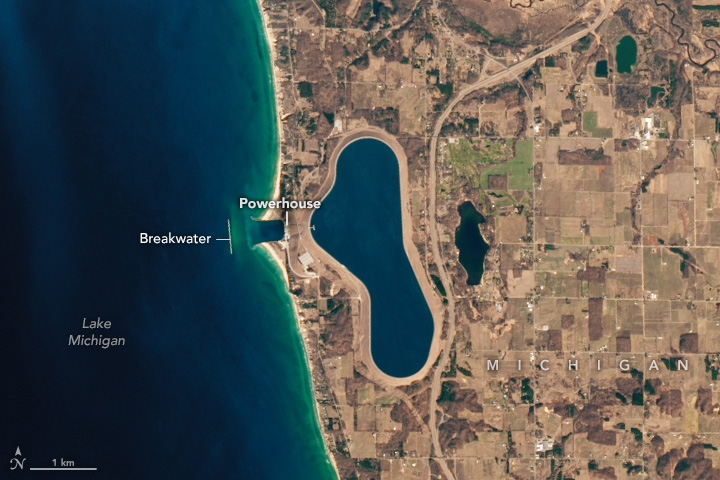
One of the Largest Batteries in the World
Downloads
- energystorage_oli_20240303_lrg.jpg (1394x929, JPEG)
Metadata
- Sensor(s):
- Landsat 8 - OLI
- Data Date: March 3, 2024
- Visualization Date: May 9, 2024
This reservoir holds more than just water. Set on a bluff hundreds of feet above Lake Michigan, it also stores potential energy that can be unleashed to produce hydropower. This human-built lake is part of the Ludington Pumped Storage Plant, a pumped storage hydropower facility that can be likened to a giant battery—one that moves water instead of electrons.
In place of complex chemistry, this battery employs simple physics. Surplus electricity from the grid is used to pump water 370 vertical feet (110 meters) from Lake Michigan to an upper reservoir, shown here. At times of higher energy demand, water flows back down, turning the pump-turbines in the opposite direction to generate hydropower. This image of the facility and reservoir was acquired by the OLI (Operational Land Imager) on the Landsat 8 satellite on March 3, 2024.
The Ludington Pumped Storage Plant began operating in 1973, making it essentially a battery that still works after 50 years. Its upper reservoir measures approximately 2.5 miles (4 kilometers) long and 1 mile (1.6 kilometers) wide, occupying 842 acres. Two jetties and a breakwater protect the intake and outflow channel from the waves and currents of Lake Michigan, and a barrier is installed from April through October, when ice conditions permit, to keep fish away from the intake.
Water rushes through six pump-turbines concealed from view within a powerhouse. Each unit raises or lowers the reservoir’s water surface about 1 foot per hour during normal operation, according to Consumers Energy, co-owner of the facility. At full capacity, the plant can power about 1.7 million households.
Michigan’s electricity comes largely from fossil fuel-fired power stations and nuclear plants. With these relatively constant sources, the Ludington plant tends to pump overnight when customer demand on the grid is low, then switch to hydropower mode during the day until its usable capacity is exhausted.
That schedule could shift as more renewable energy sources come online in the region. The Ludington plant may adapt to solar, for example, by recharging during the middle of the day and then discharging in the evening when demand increases, analysts posit. Utility-scale energy storage is critical to the wider adoption of solar and wind power; it enables these intermittent sources to be used when sunlight or wind are lacking and reduces the need for back-up fossil fuel-fired plants.
The United States may need to add hundreds of gigawatts of storage by 2050 to achieve its clean energy goals, according to the Department of Energy, and it has the potential to at least double the amount of pumped storage capacity. In 2022, 43 pumped storage hydropower plants accounted for 96 percent of U.S. utility-scale energy storage capacity, although new battery storage installations surged in 2020–2022. Most pumped storage facilities in the U.S. were built between 1960 and 1990, and some, including Ludington, have been upgraded in recent years to increase their capacity and incorporate renewable energy sources.
References
- Consumers Energy Pumped Storage Hydro Electricity. Accessed May 9, 2024.
- MLive (2023, August 16) On Lake Michigan, a giant water battery aids clean energy transition. Accessed May 9, 2024.
- National Renewable Energy Laboratory (2023, August 21) Why is Pumped Storage Hydropower Important? Accessed May 9, 2024.
- U.S. Department of Energy What is Pumped Storage Hydropower? Accessed May 9, 2024.
- U.S. Government Accountability Office (2023, March 30) Utility-Scale Energy Storage: Technologies and Challenges for an Evolving Grid. Accessed May 9, 2024.
- 9&10 News (2019, May 5) Battery On The Berm: The Ludington Pumped Storage Facility. Accessed May 9, 2024.
NASA Earth Observatory image by Wanmei Liang, using Landsat data from the U.S. Geological Survey. Story by Lindsey Doermann.
This image record originally appeared on the Earth Observatory. Click here to view the full, original record.